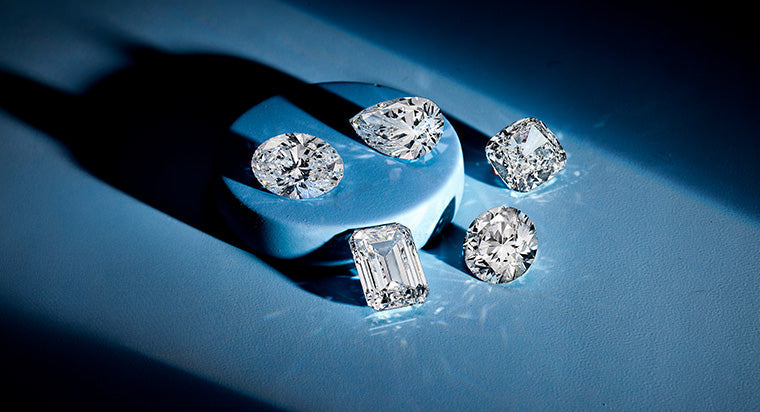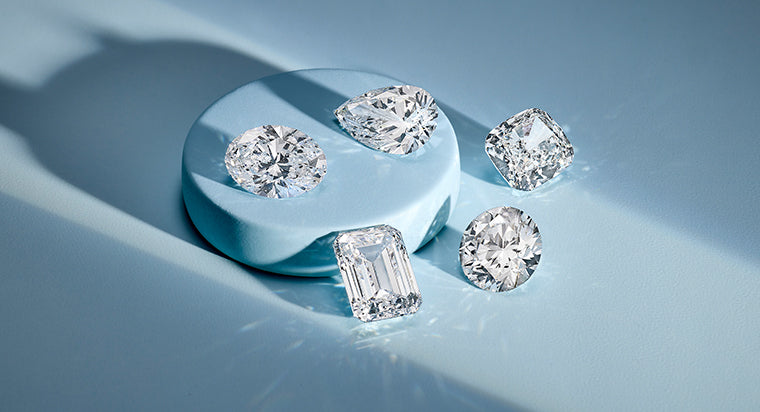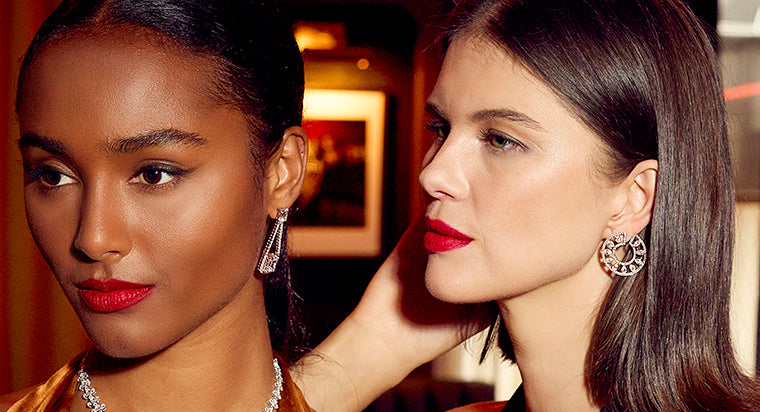Round vs. Cushion Cut Diamonds: Which One Deserves Your “YES”?

Are you confused between a round-cut and a cushion-cut diamond engagement ring? Well, you're not alone! Both shapes are on everyone’s radar in 2025—one an enduring classic, the other quickly gaining a loyal fan base. But both are equally gorgeous options for an engagement ring.
Today, we’ll help you compare the pros, cons, and sparkle of each so you can confidently choose the diamond that deserves your “YES.”
TABLE OF CONTENTS
Round-Cut Vs. Cushion-Cut Diamond Rings: An Overview
The Round Cut
Let’s first talk about the round-cut diamond—an evergreen stunner and a true crowd favorite. Cherished for its timeless appeal and dazzling sparkle, round-cut diamond rings are crafted with 58 precisely angled facets designed to bounce light brilliantly. Fun fact: nearly 75% of all diamonds sold today are round-cut, showing just how universally loved this cut is! Numerous celebrities, including Mila Kunis, Miranda Kerr, Michelle Obama, and Emily Blunt, all sport round-cut engagement rings, proving that this shape remains timeless. You can set them in a sleek solitaire, a trendy halo, or a timeless vintage – they’ll always look stunning.
The Cushion Cut
Next, let’s shine the spotlight on the cushion cut diamond—a gorgeous choice that blends vintage charm with a touch of modern flair. Shaped like a soft square (or a rectangle) with rounded corners, cushion-cut diamonds resemble a (sparkly) pillow. Fun Fact: Although they may seem modern and new, they are not. This shape first emerged in the 19th century, which means it is over 200 years old.
Cushion diamonds have larger facets that create a beautiful, romantic glow rather than an intense, blinding sparkle, giving it a softer, candlelit vibe that many people adore. Just like round-cut diamonds, cushion-cut diamonds have a devoted fan following and have graced the fingers of celebrities such as Kim Kardashian, Sofia Vergara, and Meghan Markle. Whether showcased in a simple solitaire or surrounded by a vintage-inspired halo, the cushion cut exudes romance and timeless elegance.
Cushion Cut Variants: Which Type Should You Choose?
While round-cut diamonds have no distinct variants, cushion-cut diamonds come in several:
- Standard Cushion (58 facets): Offers a classic, antique look with intense brilliance.
- Modified Brilliant Cushion ( 58 – 64+ facets): Adds sparkle and fire compared to the standard.
- Crushed Ice Cushion (70–80+ facets): Known for intense, glittering sparkle and is excellent at hiding inclusions.
- Elongated Cushion Cut Diamond: Creates a graceful, lengthening effect on the finger, similar to oval diamonds.
Some cushion styles enhance brilliance (like modified brilliant and crushed ice), while others emphasize shape or face-up size. Round cuts still top the sparkle chart, but cushion variants are not far behind. They also allow for more customization in terms of uniqueness and style. Regardless of shape, we recommend buying a GIA-certified stone, especially lab diamonds, to evaluate proportions, symmetry, and cut quality.
Shape Comparison: Cushion vs. Round for Modern Brides
In 2025, round diamonds and cushion cut diamonds are both great options if you’re shopping for an engagement ring.
The round cut has dominated the popularity charts for eons, and trend reports confirm that we can expect this to continue. While round diamonds have a classic look, when paired with trendy settings and chunky metal bands, they can feel perfect for a contemporary bride. On the other hand, cushion-cut engagement rings offer a vintage charm, which makes them ideal for a modern bride who wants to showcase her individuality.
It’s also worth noting that although cushion cuts have surged in popularity over the past decade, they are now facing competition from other shapes, such as oval and emerald cuts, according to PriceScope. Still, the elongated cushion-cut diamond remains one of the top choices for custom designs in 2025, alongside oval diamonds.
For oval versus cushion diamond comparison, look at how each looks on your finger.
Cushion vs Round Diamond Sparkle: Which Shines Brightest in 2025?
If you're looking for the best diamond cut for maximum sparkle in 2025, round-cut diamonds are the clear winner. With 58 precisely angled facets, round brilliant lab diamonds are precisely engineered to reflect maximum light, earning them the highest brilliance score of any shape (9.5–10/10). Their symmetrical design disperses light evenly through the crown and pavilion of the stone, resulting in unmatched fire and scintillation.
Lab-grown cushion cut diamonds, on the other hand, offer a softer, more romantic glow. Their larger facets (or chunkier patterns in standard cuts) produce a “pillowy” sparkle that feels vintage and warm. However, this also means they don’t bounce light as intensely as round cuts, ranking 7.5–9/10 on the sparkle scale. If brilliance is your priority, we suggest a modified brilliant or crushed-ice cushion cut, which has more facets (up to 80+) to enhance sparkle and mask inclusions better than the standard cushion cut.
Clarity & Cut Comparison: Cushion vs Round
Speaking of inclusions, don’t let a diamond’s sparkle cause you to overlook its clarity. Due to the facet arrangement, round diamonds are more adept at hiding inclusions and any presence of color within the stone. Cushion cuts—with fewer or larger facets—can accentuate imperfections, so always inspect clarity grades or opt for a style like crushed ice to minimize their visibility.
Round vs Cushion: How Different is the Price?
Cushion cuts are generally 25% more affordable than round cuts. This is because more of original rough stone is lost when cutting a round diamond. But if you’re set on a round-cut diamond and are shopping for an engagement ring on a budget, consider lab-grown diamonds.
Lab-grown diamonds are chemically, physically, and optically identical to mined diamonds, which means they’re just as hard in terms of durability plus sparkle and look the same. However, they are inexpensive in comparison, allowing couples to choose high-quality diamonds at reasonable prices or even opt for larger carat sizes.
Average Prices for Round and Cushion Natural and Lab Diamonds
We’ve put together a comparison chart to help you understand how natural and lab diamonds compare in terms of pricing. Here’s a cost comparison for diamonds with G color, VS2 clarity, and a very good cut.
| Type of Diamond | 1.00 Carat |
|---|---|
| Natural Round Diamonds | $6,000 – $8,500 |
| Lab Round Diamond | $1,200 – $2,000 |
| Natural Cushion Diamonds | $3,200 – $4,200 |
| Lab Cushion Diamonds | $500--$900 |
The bottom line? If you’re looking for affordable round-cut engagement ring options, then lab-grown is your answer. And cushion-cut lab diamonds offer even better value.
Which Cut Suits Your Finger & Style?
If you have broader or shorter fingers, an elongated cushion-cut diamond can create a longer, more elegant look. In contrast, slender fingers pair beautifully with the timeless symmetry of a round cut. For those seeking a larger-looking ring, the cushion cut is a great choice; however, if maximum sparkle is your priority, the round cut remains unmatched.
Choosing Between a Cushion or Round Diamond: What To Pick?
Although your bride-to-be's tastes should be the primary concern when choosing a diamond shape, sometimes two shapes can be truly tied. When that happens, it helps to consider what each of these diamond shapes does best and compare that to her priorities for her diamond.
Both shapes bring unique brilliance and style. Round cuts are iconic for sparkle and versatility. Cushion cuts offer romantic flair, face-up value, and charm. Thanks to lab-grown diamonds, you don’t have to sacrifice size, ethics, or sparkle for budget.
Let your personal style and preferences guide the way—and say “yes” to the diamond that fits your love story.
Trending Ring Settings for 2025
So, have you decided on which cut you like better? If so, we’ve put together our favorite cushion and round-cut diamond engagement rings, which you can shop right away.

French Cut Pave Diamond Engagement Ring
If you love a ring with subtle details, consider this piece. Delicate yet striking, this ring showcases a brilliant round-cut diamond that shines brightly on a band embellished with a petite pavé diamonds.

The Bond Engagement Ring
For the bride who wants a ring that’s bold and unique, this one’s for you. A sculptural masterpiece, this ring features a round-cut diamond set atop a Möbius-inspired band. Micro-pavé diamonds accentuate its graceful curves, and a hidden halo of diamonds amplifies the sparkle factor, enhancing the ring’s radiance.

Floral Twisted Halo Lab Diamond Engagement Ring
Something about a vintage engagement ring always draws the eye, and this ring proves that. Nestled amid a floral twisted halo of diamonds, the cushion-cut stone makes a glamorous statement. The twisted shanks, graced with accent diamonds, further amps up the grandeur of this piece, making it perfect for a bride who loves old-world charm.

The Solmare Engagement Ring
You and your partner have seen ups and downs together and emerged stronger than ever. What better way to symbolize your ever-growing relationship than a wave ring? The Solmare engagement ring captures that beautiful ebb and flow with its stunning design. Lined with pavé-set diamonds, the curved band cradles a round-cut diamond and shimmers with every movement. It’s modern, meaningful, and effortlessly romantic—made for a love that keeps rising.

The Elise Three Stone Engagement Ring
A timeless trio with a shimmering twist. A bold, cushion-cut stone is flanked by radiant-cut side diamonds, creating a refined balance of brilliance and symmetry. Petite pavé diamonds trace the scalloped bridge and wrap around the band in a near-continuous flow, creating sparkle from every angle.
PS: If you want to see more stunning options, head to With Clarity right away. From dazzling halos to trendy Toi Et Moi rings, we’ve got a ring for every bride.
FAQs
Which cut sparkles more?
Which cut looks larger per carat?
Which Cut is Best for Short Fingers?
Which cut is more affordable in lab-grown?
Do lab-grown cushion diamonds look different from natural ones?









